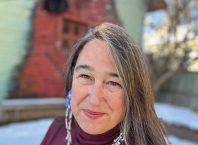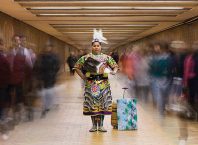By Benjamin Gessner
Cultural artistic practices are continuous; they are passed down from one generation to the next. Each generation – and each artist – makes choices about what they will retain and what they will alter in order to express themselves, while still paying respect to those that came before them. Due to the legacy of colonialism, of intense pressure to change lifeways, and of the collecting of Native American materials by non-Natives, sometimes this transference of artistic knowledge has been interrupted.
Museums must recognize their colonial legacy, and they must serve as resources for Native communities. They should act as a platform for traditional artists to connect with works created by their ancestors that are held in collections, and should also provide support for community members who are learning, practicing, teaching and oftentimes recovering cultural art forms.

In 2014, the Minnesota Historical Society (MNHS) developed – and has since operated – the Native American Artist-in-Residence Program (NAAIR) to support the continuation and recovery of traditional material arts. NAAIR is one of only a few similar programs across the country and unique in its design. Participating artists are selected through an application process by an advisory panel consisting of culturally knowledgeable, community member experts; to date, jurors have included writers, curators, community advocates and artists – all Native American and all connected to the region.
Each residency award provides individual artists with$25,000, open access to the MNHS collections, a travel stipend and support to visit regional museums or other knowledgeable peer artists or elders, and the promise to purchase at least one artwork for the museum permanent collection. Each resident artist is expected to reach into their community to share what they’ve learned during their time as a resident.
Between 2014 and 2016, the NAAIR program served five artists and their communities. Beginning in September, 2017, works by these artists will be on exhibit at the History Center museum in St. Paul.
Jessica Go key, a bead work artist, is an enrolled member of the Lac Courte Oreilles (LCO) tribe in Wisconsin. During her residency, Jessica studied numerous examples of Ojibwe beadwork. Inspired by a 19th Century Ojibwe table covering, she created her piece Native Foods Ojibwe Beadwork Tablecloth which illustrates nearly 20 traditional plants used as food or medicine.
Pat Kruse is a birchbark artist enrolled in the Red Cliff Band of Lake Superior Chippewa who lives in the Mille Lacs community in Minnesota. Pat studied a wide range of historic birchbark pieces and recreated many of the forms, embellishing them with his own unique style. He and his son, Gage, created more than 40 different patterns, each based on a specific historic object. Pat distributed copies of these patterns to more than 20 Tribal Nations in the Great Lakes area. “These aren’t my patterns,” he told them. “They’re ours.”
Denise Lajimodiere is an enrolled citizen of the Turtle Mountain Band of Chippewa in North Dakota. She practices Mazinibakajige, the Ojibwe art of birchbark biting (the Ojibwe word translates to “pictures upon the bark”). During her residency, Denise connected with the handful of other artists in the U.S. and Canada who practice this art form. Committed to the revitalization of this unique cultural artform, Denise lectures, holds workshops, and works one-on-one with apprentices.
Gwen Westerman is an enrolled member of the Sisseton Wahpeton Dakota Oyate. Over the course of her residency, Gwen examined the practice of Dakota ribbon-work applique, which has often been associated with American Indian cultures from further east than Minnesota, the traditional homeland of her ancestors, the Dakota.
Gween said, “Working with collections of textile works made by Dakota women brought me into direct contact with their techniques… Holding their work in my hands, some of it 160 years old, was like holding their hands.”
Holly Young is a Dakota bead work artist enrolled in the Standing Rock Sioux Tribe. As a Resident artist, Holly studied collections at MNHS and many other institutions across the country. As floral work in this region is often strictly associated with the Ojibwe, Holly is committed to revitalizing the artistry and collective understanding of the unique style of historic Dakota floral bead work.
The Native American Artist in Residence program is currently seeking submissions for the upcoming round of funding. Artists from the four state region of Minnesota, Wisconsin, North Dakota and South Dakota who are practicing traditional material arts are encouraged to apply.
NAAIR is open to Native American artists currently residing in Minnesota, Wisconsin, North Dakota and South Dakota. Enrollment in a federally recognized tribe is not a requirement, but the artist must be recognized by his or her community and demonstrate significant artistic knowledge. Deadline is April 1, 2017.







